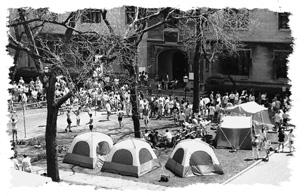 |
|
|
Online, not in line The University’s new Internet systems eliminate the long lines—and sleeping bags—of yesteryear.
For about five years University officials and technology experts have quietly toiled to bring administrative systems into the 21st century, foreseeing a day when students could register, add and drop courses, change addresses, pay bills, and view transcripts, financial aid, and permanent records through a central e-portal. Though the paper-to-Internet switch is ongoing, by now those major systems have been transferred to a new platform, named Gargoyle, in what Steve Klass, vice president and dean of students in the University, calls a removal of “ridiculous bureaucratic barriers.” Gone are the days when undergraduates camped out for classes or affixed stickers to their ID cards for gym privileges. Now first-years’ registration information is in the University’s computer system when they arrive, and their ID cards—issued during Orientation Week—access cafeterias as well as Ratner Athletic Center. “We’re here to support students’ academic success,” Klass says, “not to make people run to multiple buildings to do different things. You don’t have to touch paper in any other part of your life, like banking, so why should you do so here?” The project—a joint effort between the Office of the Registrar, the Office of the Bursar, Networking Services and Information Technologies (NSIT), and various deans’ offices—began in 1999, spurred by the increasing age and maintenance costs of the previous Student Information System (SIS), a legacy database from 1979. When a lightning bolt knocked out SIS’s power supply in 2000 and staff had to retype lost records, administrators had a striking reminder of how urgently Chicago needed a modern system. The power outage combined with “students’ desire to do stuff online,” says Alex Henson, AB’90, MBA’96, NSIT’s director of student and development applications, “galvanized us.” The $7.8 million changeover has been gradual, says Henson, who leads the project’s technical aspects. Billing and health-care selection, for example, went online last year. Since June students could add and drop courses electronically at any time, rather than the three-week periods previously designated to avoid a system overload. With academic records’ August transfer, by this fall Gargoyle has become the central platform for students—once they enter a CNet ID and password—to access their grades, transcripts, and other information. Students find such data at cMore.uchicago.edu—a reference to the 2002 Aims of Education address, in which sociology professor Andrew Abbott, AM’75, PhD’82, argued that an educated person viewing a painting will “see more” than an uneducated person because he or she has learned its historical and artistic contexts. Because students can see more via the Web, the bursar’s and registrar’s offices “have become less clerical and more troubleshooting,” Klass says. “It used to be a student’s first line of contact was just to get basic information—what’s my balance? Now the student has already been online,” so a call or visit is more substantive. Registrar Tom Black, who chairs the student-systems committee, agrees that the change has allowed his staff to focus on more pertinent tasks. “I used to have a person who did nothing but enter addresses,” he says. “Now that person enters courses into the system, and we’re able to get time schedules up earlier.” The registrar’s Web site also includes headcount statistics, so a user can quickly find, say, the number of students enrolled last spring in the public-policy Ph.D. program (24). Faculty and deans’ offices benefit too. They’re able to add courses electronically rather than via piles of paperwork, see real-time class rosters, and keep grades updated throughout the year. The result, Klass says, is “what day trading did to the stock market.” Although the system is centralized, administrators worked with the divisions and schools to meet their different needs. The Law School, for example, was able to keep its number-based grading scale rather than conform to the rest of the University’s letter-based method. Still, the system has its critics. Long-term faculty have balked at needing a CNet ID or having to assign their names early in the current term to next quarter’s courses so the class can be entered into the computer system. Some students, meanwhile, complain that cMore doesn’t seem as revolutionary as administrators claimed in a mass e-mail last year. The registration site, for instance, doesn’t warn when scheduled class times overlap. And third-year Breandan Gleason, a residential computing assistant, notes that students can’t “change their billing information and course schedule without being redirected to another Web site,” where they are “forced to log in again.” But Gleason recognizes that cMore is a work in progress, and Henson argues that Chicago has created an online administrative system faster, cheaper, and with broader University-wide consensus than other institutions. Additional amenities are on the way. By winter,
Black says, students will apply to graduate online, and soon they’ll
not only see their financial aid on cMore but also, Henson says,
complete federal forms and upload them directly into the system.
|
|
phone: 773/702-2163 | fax: 773/702-8836 | uchicago-magazine@uchicago.edu


 Chris
Dahlen
Chris
Dahlen